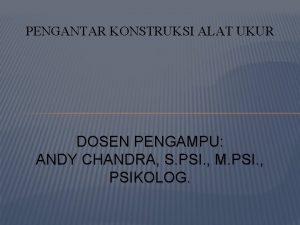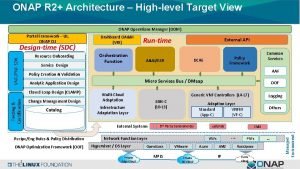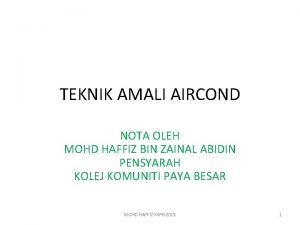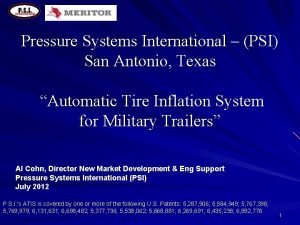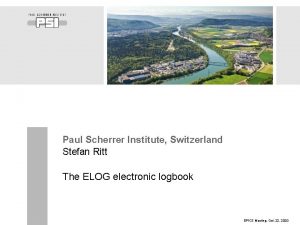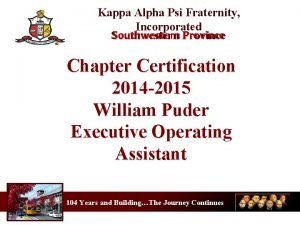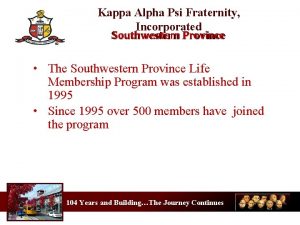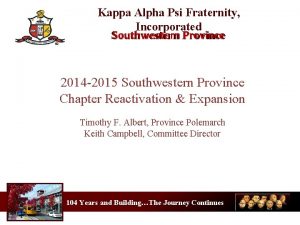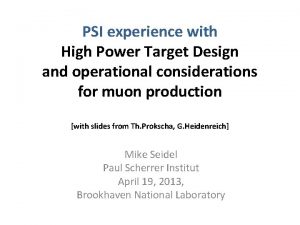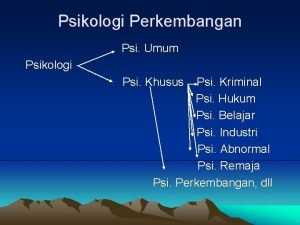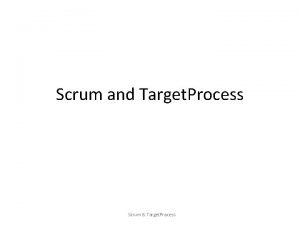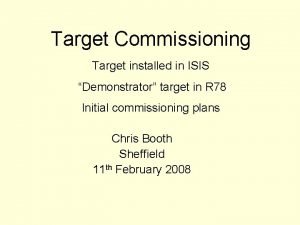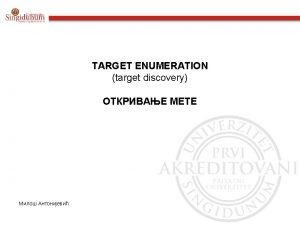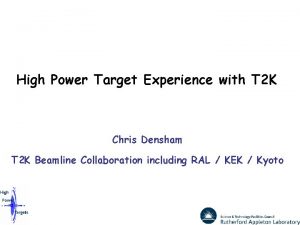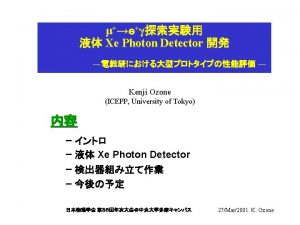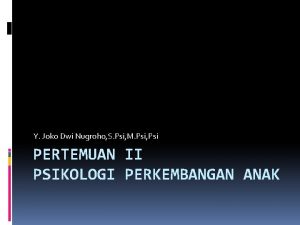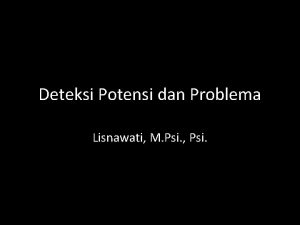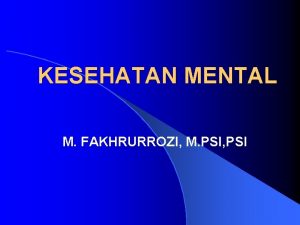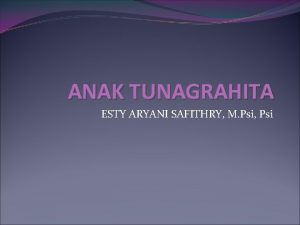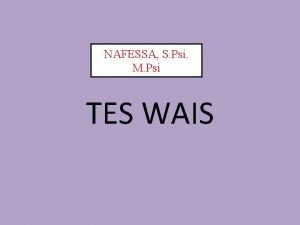PSI experience with High Power Target Design and
















![Muon- capture: Layout of the m. E 4 high-intensity m beam [Th: Prokscha] Muon- capture: Layout of the m. E 4 high-intensity m beam [Th: Prokscha]](https://slidetodoc.com/presentation_image_h2/0ddadfd5d04a85e058c94de74f8a9967/image-17.jpg)





- Slides: 22

PSI experience with High Power Target Design and operational considerations for muon production [with slides from Th. Prokscha, G. Heidenreich] Mike Seidel Paul Scherrer Institut April 19, 2013, Brookhaven National Laboratory

Outline • overview PSI targets and parameters • thermomechanical target aspects, mechanics and supporting infrastructure • example for μ-beam capture and transport • discussion

PSI proton accelerator complex SINQ, neutron spallation source Dolly GPD LEM High field (9. 5 T) m. SR MEG UCN 50 MHz proton cyclotron, 2. 2 m. A, 590 Me. V, 1. 3 MW beam power (2. 4 m. A, 1. 4 MW test operation) GPS/LTF proton therapy, irradiation facility Comet cyclotron (superconducting), 250 Me. V, 500 n. A, 72. 8 MHz

Meson production targets used at PSI 1974 -80 < 100 A Target M Target E Be, Graphite *) 190 mm 0. 9 g/cm 2 Be, Graphite *) 190 mm 22 g/cm 2 Pyrolitic graphite**) 22 g/cm 2 1980 -89 since 1990 250 A 0. 5 - 2 m. A Graphite *) 320 mm 0. 9 g/cm 2 Graphite *) 280 mm 18 g/cm 2 Graphite *) 450 mm 10 g/cm 2 (60 mm) or 7 g/cm 2 (40 mm) *) rotating wheel target **) static target

Target-M design Target M: P-BEAM Mean diameter: 320 mm Target thickness: 5. 2 mm Target width: 20 mm Graphite density: 1. 8 g/cm 3 Beam loss: 1. 6 % Power deposition: 2. 4 k. W/m. A Operating Temperature: 1100 K Irradiation damage rate: 0. 12 dpa/Ah Rotational Speed: 1 Turn/s

Exchange of Target-M Operation of the remotely controlled shielded flask Dose rate ~10 m. Sv/h

Design of the proton channel between target-E and the beam dump BEAM DUMP

Working platform / Operation of the remotely controlled shielded flask

Design of Target station E BACKWARD SHIELDING TARGET CHAMBER INFLATABLE ALL-METAL SEAL COLLIMATOR 2 & 3 Beam losses: 22/18 % p TARGET E: 6/4 cm Beam losses: 18/12 % FORWARD SHIELDING COLLIMATOR

Target-E design Drive shaft TARGET CONE Mean diameter: 450 mm Graphite density: 1. 8 g/cm 3 Operating Temperature: 1700 K Irradiation damage rate: 0. 1 dpa/Ah Rotational Speed: 1 Turn/s Target thickness: 60 / 40 mm 10 / 7 g/cm 2 Beam loss: 18 / 12 % Power deposition: 30 / 20 k. W/m. A SPOKES To enable thermal expansion of the target cone BALL BEARINGS *) Silicon nitride balls Rings and cage silver coated Lifetime 2 y *) GMN, Nürnberg, Germany p-beam

Drive motor & permanent-magnet clutch vacuum Ball bearing air pressure Permanent-magnet clutch DC-motor Record of the drive torque for the rotation

design of graphite wheel The gaps allow unconstrained dimensional changes of the irradiated part of the graphite.

Temperature & stress distribution (2 m. A, 40 k. W) 600 K 1700 K 5 MPa

Maintenance of the target-insert in the hot-cell Exchange parts: horizontal drive shaft

Operational limits of the rotating graphite & beryllium cones for target-E 3 m. A operation of Target-E D = 0. 45 m Temperature (K) e* = 0. 7 Safety factor syp/s I(m. A): Proton current C Be D(m) : Mean target diameter * : effective emissivity Evaporation rate (mg/g/year) [G. Heidenreich]

Lifetime of the pyrolitic graphite targets due to irradiation -induced dimensional changes Operational parameters: Proton current: Peak current density: Peak temperature: Swelling of the target after irradiation 100 A 1000 A/cm 2 1800 K 1022 p/cm 2 p p Dimensional change (%) Lifetime limits: Proton fluence: 1022 p/cm 2 Integrated beam current: 50 m. Ah Irradiation-induced swelling: ~ 10 % Irradiation damage rate: ~ 1 dpa 70 60 50 40 30 20 10 0 -10 -20 -30 —— —— 1273 - 1423 K 1473 - 1573 K ~ 1 dpa 0 2 4 6 8 10 12 * 1021 N/cm 2 Neutron Fluence J. Bokros et. al, Carbon 1971, Vol. 9, p. 349
![Muon capture Layout of the m E 4 highintensity m beam Th Prokscha Muon- capture: Layout of the m. E 4 high-intensity m beam [Th: Prokscha]](https://slidetodoc.com/presentation_image_h2/0ddadfd5d04a85e058c94de74f8a9967/image-17.jpg)
Muon- capture: Layout of the m. E 4 high-intensity m beam [Th: Prokscha]

Transport and TRACK calculations TRANSPORT: PSI Graphic Transport y x framework by U. Rohrer, based on a CERN-SLAC-Fermi. Lab version by K. L. Brown et al. 0% p/p 1 st 3% p/p (FWHM): 5% - 9. 5% 1 st 3% p/p 2 nd y TRACK: Three-dimensional Ray x Tracing Analysis Computational Kit, developed by PSI magnet section (V. Vrankovic, D. George)

Solenoid versus quadrupole First order transfer matrix for static magnetic system with midplane symmetry: ➨ First order transfer matrix for a solenoid, mixing of horizontal and vertical phase space: ➨ Mixing of phase space might lead to an increase of beam spot size Rotation of phase space: 90 x-y PS exchanged Focusing powers PS, T of solenoid and triplet at same power dissipation in device: Azimuthal symmetry of solenoids leads to larger acceptance

Double-solenoid WSX 61/62 Bmax = 3. 5 k. G Øi = 500 mm

Installation of a section of m. E 4 in 2004

Discussion • PSI concept is optimized for dual use of beam (Meson and Neutron Production); C = low-z material; strong focus at target: minimize emittance growth • beam loss at 40 mm C-target: 10% inelastic nuclear interactions; 20% collimation of spent beam • rotating graphite target concept with radiation cooling was optimized over many years; lifetime limited by anisotropy of graphite and resulting wobbling from radiation damage; pyrolithic graphite not suited! • service and exchange systems, Hotcell are VERY IMPORTANT for practical operation • Muon figures: ≈5∙ 108 μ+/s possible @p=28 Me. V/c; p/p=9. 5%FWHM; x/y = 5/10∙ 10 -3 m∙rad T. Prokscha, et al. , Nucl. Instr. and Meth. A (2008), doi: 10. 1016 /j. nima. 2008. 07. 081 • activation after one year: order of 1… 5 Sv/h; thanks to Graphite this is low compared to heavy target materials! • issues: Tritium production in porous material; oxidation of graphite with poor vacuum of 10 -4 mbar; carbon sublimation at higher temperatures; wobbling of wheel caused by inhomogeneous radiation damage
 Andy chandra s.psi m.psi
Andy chandra s.psi m.psi What is indirect experience
What is indirect experience Primary target market and secondary target market
Primary target market and secondary target market Imprint definition psychology
Imprint definition psychology Early experience vs. later experience
Early experience vs. later experience Power triangle
Power triangle Accessible learning experience design and implementation
Accessible learning experience design and implementation High level target
High level target Offshore treatment providers
Offshore treatment providers Target markets and channel design strategy
Target markets and channel design strategy The arrangement of the element of curriculum
The arrangement of the element of curriculum Directive supportive leadership
Directive supportive leadership Directive behavior
Directive behavior Bacaan tekanan gas aircond rumah
Bacaan tekanan gas aircond rumah Psi sigma alpha osteopathic honor society
Psi sigma alpha osteopathic honor society Phi-blast
Phi-blast Psi san antonio tx
Psi san antonio tx Security investigation types
Security investigation types Psi elog
Psi elog Southwestern province kappa alpha psi
Southwestern province kappa alpha psi Southwestern province
Southwestern province Kappa alpha psi life membership card
Kappa alpha psi life membership card Swp kappa alpha psi
Swp kappa alpha psi
